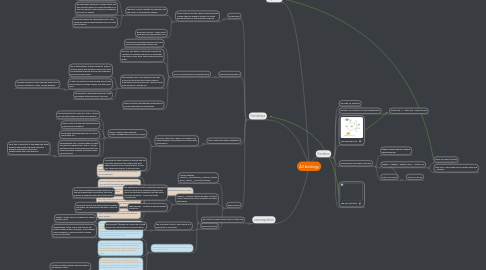
1. osmoregulation
1.1. the control of water and salt levels in the body
1.1.1. increase in water potenital(drinking more water, cold day)
1.1.1.1. detection-osmoreceptors in the hypothalamus detect this change, they do not stimulate neurosecratory cells since the osmoreceptors are not shrinked
1.1.1.2. effect: the effect is that since neurosecratory cells are not stimulated they do not causee a action potential to arrive to the posterior pituatry gland and therefore less adh released into the blood.
1.1.1.3. this means that the adh receptors in the kidney do not detect this and so aquaprins do not fuse to the mebrane of the collecting duct
1.1.1.4. decrease in water potential meaning that more water is urinated on a cold day with plentifull water uptake.
1.1.2. decrease in water potential (dehydration, hot day , water loss)
1.1.2.1. detection- osmosreceptors in the hypothalamus respond to the low water potential causing shrinkage of the cells. this shrinkage of the cells stimulates neurosecratory cells which send an action potential down the axon to the posterior pituatry.
1.1.2.2. effect: when an action potential arrives from the neurosecratory cells the pituatry gland(which stores adh) releases the adh into the blood via cappliary systems in the posterior pituatry gland
1.1.2.3. increased levels of adh are detected by cell surface receptors in the collecting ducts of the kidney, causiing a chain of enzyme controlled reactions which result in aquaporins to be inserted in the surface membrane allowing more reabsorption of water
1.1.2.3.1. increase in water potential and less water in urinated as a result
2. the kidneys
2.1. ultrafiltraion
2.1.1. blood flows in from the afferent arteriole which is wider than the efferent arteriole to create enough pressure in the bowamans capsule
2.1.1.1. there are 3 layers between the capilaries and the lumen of the bowmans capsule
2.1.1.1.1. endothelial of cappilaries-has fenestrations
2.1.1.1.2. the basement membrane-collagen fibres and glyco protien,barrier for molecules with mr of less than 69000-most protiens and redblood cells are not filtered
2.1.1.1.3. podocytes-these are the epithelia cells of the bowmans capsule-gaps between each cell allow extra filtration.
2.1.1.2. glomerulas filtrate---water,amino acids,glucose,urea,inorganic ions
2.2. selective reabsorption
2.2.1. occurs in the proximal convulated tubule
2.2.1.1. the proximal convulated tubules cells have microvilli incressing the surface area
2.2.1.2. the cells also have co transporter proiens are indication of faciltaed diffusion for movement of glusoce, amino acids some sodium ions and water.
2.2.1.3. the opposite end of the membrane also has mmicrovilli strucutre and contains sodium potassium pumps to pump na+ into the tissue fluid and and k+ into the cell
2.2.1.3.1. atp is hydrolised to actively transport sodium into the blood, this allows for more na to move by faciltaded diffusion into the cell along with glucose or amino acids
2.2.1.3.2. as the concentraion of glucose and amino acids build up they can simply diffuse into the tissue fluid
2.2.1.3.3. some water is reabsorbed because of the decreased water potential in the cells
2.2.1.4. larger molecules that passed the glomerulus can be reabsorbed by endocytosis
2.3. loop of henle and water reabsoption
2.3.1. the role of the loop of henle is to create a low water potenial in the medulla to increase water reabsorption
2.3.1.1. hairpin cuntercurrent multiplier system-arrangement of the loop of henle
2.3.1.1.1. the descending limb- some na+ and cl- diffuse into the descending limb note this is diffusin
2.3.1.1.2. water is lost from the descending limb by osmosis due to gradient
2.3.1.1.3. as we reach the ascending limb na+ and cl- now diffuse out
2.3.1.1.4. the ascending limb- is impermeable to water and actively transports na+ and cl- out the limb(atp present mitochondria present) this means the water potential increases up the ascending limb
2.3.1.2. collecig duct-water moves by osmosis due the low water potenial in the medulla and high water potential in the collecting duct, moves into capaliries and back to the renal vein.
2.4. kidney failure
2.4.1. causes-diabetes melititus,,,,,hypertension,,,infection,,,kidney stone,,,cancer,,,,,,excessive drinking
2.4.2. Dialysis -- involves dyalis fluid which contains correct amounts of salts urea,water and other substances
2.4.2.1. any substance in excess in the blood diffuses to dyalisis fluid and any substance which is too low in concentraion diffueses from the dyalis fluid into the blood -- this corrects the concetraions
2.4.2.1.1. once the concretnraions of the substances in the blood have been correcteced, the dyalis membrane seperates the fluid and the blood
2.4.2.2. haemodialysis - contains a artificial dialysis membrane
2.4.2.2.1. peritoneal dialysis uses the peritoneum which is the bodys own abdominal mebrane to filter the blood
2.4.3. kidney transplant
2.4.3.1. the old kidney is left in place unless it is infectious or cancerous.
2.4.3.1.1. the donated (1)kidney can come from a living doner from living relative or someone dead
3. respiration
4. Excretion
4.1. the need for excretion
4.2. equation for removal of co2 and deamination
4.2.1. amino acid------keto acid + ammonia nh3
4.3. the ornithine cycle
4.4. detoxification of alcohol in the liver
4.4.1. ethanol dehydrogenase+ethanal dehydrogenase
4.4.2. ethanol---ethanal---ethanoic acid----acetyl coA
4.4.2.1. acetyl coA goes to krebs
4.4.2.2. fatty liver--not enough Nad to oxidise fatty acid --cirrhosis
4.4.3. Nad +2H=RNAD
4.4.3.1. Nad +2H=RNAD

